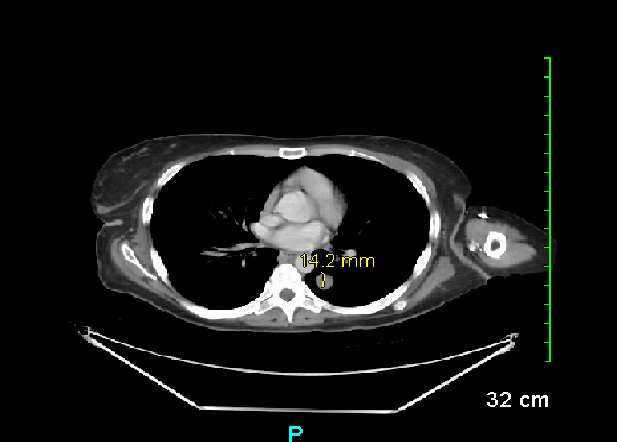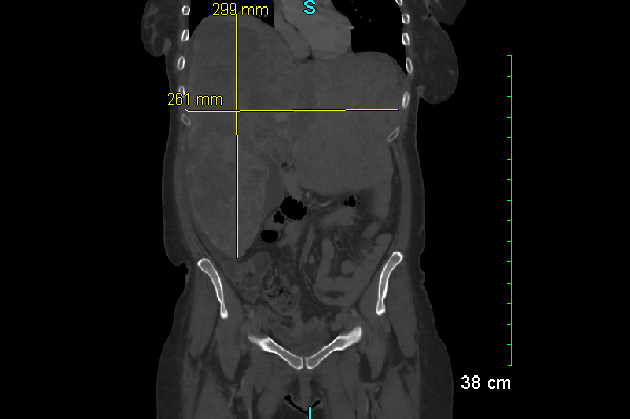Sunday Poster Session
Category: Biliary/Pancreas
P0154 - Aggressive Metastatic Intrahepatic Cholangiocarcinoma in a Young Patient
Sunday, October 26, 2025
3:30 PM - 7:00 PM PDT
Location: Exhibit Hall
- LN
Lay She Ng, MBChB
Indiana University School of Medicine
Evansville, IN
Presenting Author(s)
Lay She Ng, MBChB1, Sagar Patel, DO1, Aladdin Dahbour, MD2
1Indiana University School of Medicine, Evansville, IN; 2Indiana University School of Medicine, Indianapolis, IN
Introduction: Cholangiocarcinoma is a rare and aggressive malignancy of biliary tree, with its incidence, particularly of intrahepatic cholangiocarcinoma, rising in the United States. This case highlights diagnostic challenges in a young patient with metastatic intrahepatic cholangiocarcinoma.
Case Description/
Methods: A 40-year-old African American woman with a history of recurrent hidradenitis suppurativa presented with right-sided abdominal and flank pain, nausea, 100-lb unintentional weight loss, and oligomenorrhea over two years. No malignancy workup was done until worsening symptoms led to hospital admission. CT Abdomen/ Pelvis revealed hepatomegaly with innumerable hepatic masses, multiple pulmonary nodules and bilateral inguinal lymph nodes. Liver biopsy revealed malignant glandular cells forming infiltrative nests and glands, positive for CK7 and CDX-2, and negative for CK20, GATA-3, TTF-1, p40, and HepPar-1. Despite treatments including cisplatin/gemcitabine/durvalumab, pemigatinib, and FOLFOX, the disease further progressed with spinal, sternal, pulmonary, hepatic, and soft tissue metastases.
Discussion: Cholangiocarcinoma typically presents between ages 60–70, but increasing cases in younger individuals demand attention. This patient, diagnosed at age 37 with no identifiable risk factors, exemplifies the need to consider malignancy in patients with persistent weight loss and systemic symptoms. Her delayed diagnosis highlights the importance of maintaining a high index of suspicion and addressing potential barriers to timely care. The advanced stage at diagnosis in this patient raises questions about potential factors contributing to the delay. While specific causes are uncertain, studies suggest that socioeconomic status and racial disparities can play a role in delayed diagnosis and access to guideline-recommended diagnostic procedures. These factors underscore the need for improved healthcare access and early detection strategies, particularly for younger patients who may face barriers to timely and comprehensive cancer care. This case highlights the critical need for heightened awareness, improved early detection strategies, and equitable healthcare access for young patients presenting with persistent symptoms, as cholangiocarcinoma increasingly affects younger individuals with often advanced disease at diagnosis and poorer outcomes, despite the lack of identifiable risk factors.

Figure: CT Chest/Abdomen/Pelvis showed hepatomegaly with innumerable hepatic masses when the patient was diagnosed with intrahepatic cholangiocarcinoma

Figure: CT Chest/Abdomen/Pelvis also revealed multiple soft tissue nodules in the lungs, with a dominant 14 mm nodule within the left lower lobe.
Disclosures:
Lay She Ng indicated no relevant financial relationships.
Sagar Patel indicated no relevant financial relationships.
Aladdin Dahbour indicated no relevant financial relationships.
Lay She Ng, MBChB1, Sagar Patel, DO1, Aladdin Dahbour, MD2. P0154 - Aggressive Metastatic Intrahepatic Cholangiocarcinoma in a Young Patient, ACG 2025 Annual Scientific Meeting Abstracts. Phoenix, AZ: American College of Gastroenterology.
1Indiana University School of Medicine, Evansville, IN; 2Indiana University School of Medicine, Indianapolis, IN
Introduction: Cholangiocarcinoma is a rare and aggressive malignancy of biliary tree, with its incidence, particularly of intrahepatic cholangiocarcinoma, rising in the United States. This case highlights diagnostic challenges in a young patient with metastatic intrahepatic cholangiocarcinoma.
Case Description/
Methods: A 40-year-old African American woman with a history of recurrent hidradenitis suppurativa presented with right-sided abdominal and flank pain, nausea, 100-lb unintentional weight loss, and oligomenorrhea over two years. No malignancy workup was done until worsening symptoms led to hospital admission. CT Abdomen/ Pelvis revealed hepatomegaly with innumerable hepatic masses, multiple pulmonary nodules and bilateral inguinal lymph nodes. Liver biopsy revealed malignant glandular cells forming infiltrative nests and glands, positive for CK7 and CDX-2, and negative for CK20, GATA-3, TTF-1, p40, and HepPar-1. Despite treatments including cisplatin/gemcitabine/durvalumab, pemigatinib, and FOLFOX, the disease further progressed with spinal, sternal, pulmonary, hepatic, and soft tissue metastases.
Discussion: Cholangiocarcinoma typically presents between ages 60–70, but increasing cases in younger individuals demand attention. This patient, diagnosed at age 37 with no identifiable risk factors, exemplifies the need to consider malignancy in patients with persistent weight loss and systemic symptoms. Her delayed diagnosis highlights the importance of maintaining a high index of suspicion and addressing potential barriers to timely care. The advanced stage at diagnosis in this patient raises questions about potential factors contributing to the delay. While specific causes are uncertain, studies suggest that socioeconomic status and racial disparities can play a role in delayed diagnosis and access to guideline-recommended diagnostic procedures. These factors underscore the need for improved healthcare access and early detection strategies, particularly for younger patients who may face barriers to timely and comprehensive cancer care. This case highlights the critical need for heightened awareness, improved early detection strategies, and equitable healthcare access for young patients presenting with persistent symptoms, as cholangiocarcinoma increasingly affects younger individuals with often advanced disease at diagnosis and poorer outcomes, despite the lack of identifiable risk factors.

Figure: CT Chest/Abdomen/Pelvis showed hepatomegaly with innumerable hepatic masses when the patient was diagnosed with intrahepatic cholangiocarcinoma

Figure: CT Chest/Abdomen/Pelvis also revealed multiple soft tissue nodules in the lungs, with a dominant 14 mm nodule within the left lower lobe.
Disclosures:
Lay She Ng indicated no relevant financial relationships.
Sagar Patel indicated no relevant financial relationships.
Aladdin Dahbour indicated no relevant financial relationships.
Lay She Ng, MBChB1, Sagar Patel, DO1, Aladdin Dahbour, MD2. P0154 - Aggressive Metastatic Intrahepatic Cholangiocarcinoma in a Young Patient, ACG 2025 Annual Scientific Meeting Abstracts. Phoenix, AZ: American College of Gastroenterology.
